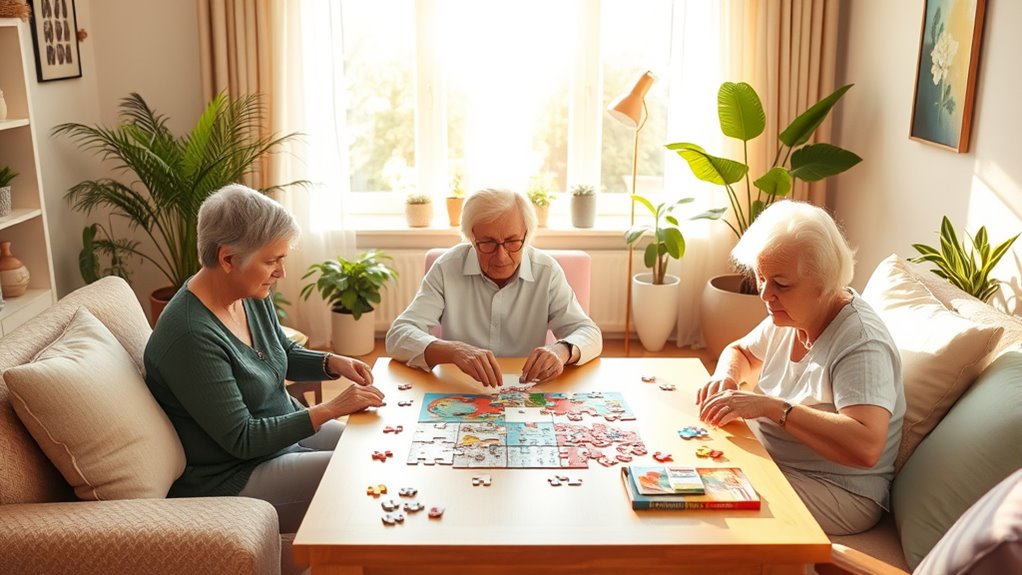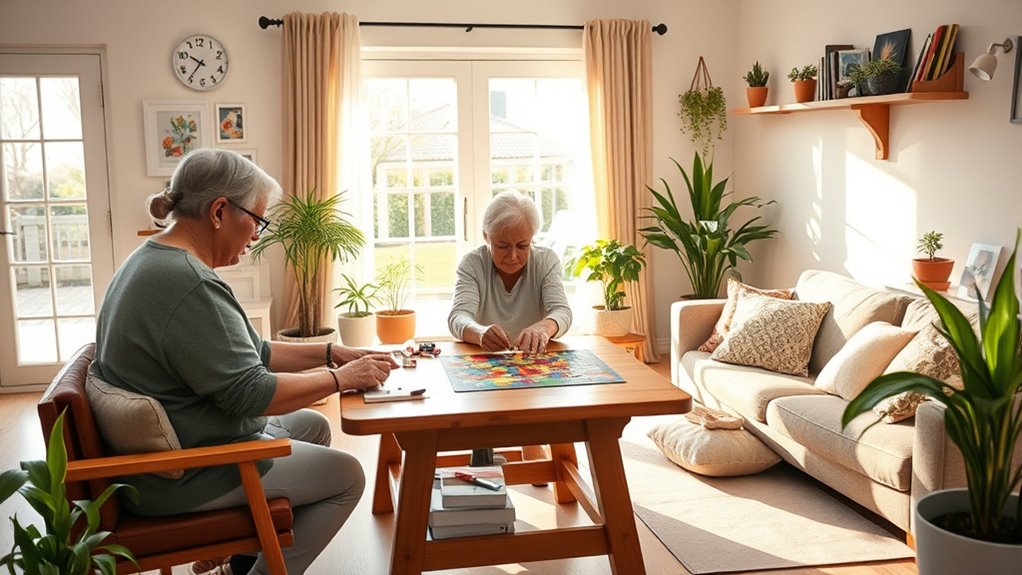To prevent sundowning, establish consistent daytime routines filled with structured activities like light exercise, hobbies, or outings in the morning and early afternoon. Incorporate sensory stimuli, such as calming music or aromatherapy, to keep the mind alert and relaxed. Balance active and quiet times, ensuring regular meal and rest periods. Maintaining a calm, predictable environment helps reduce confusion and agitation, setting the stage for calmer evenings—exploring more tips can help you create an effective plan.
Key Takeaways
- Schedule engaging, purposeful activities earlier in the day to reduce restlessness in the evening.
- Incorporate a mix of physical, sensory, and cognitive activities to promote alertness and reduce agitation.
- Maintain a consistent daily routine to provide familiarity and minimize confusion or anxiety.
- Use calming sensory stimuli during the day, like soothing music or aromatherapy, to foster relaxation later.
- Ensure a balanced day with appropriate activity levels to prevent fatigue and promote better nighttime sleep.

Sundowning, a common phenomenon in individuals with dementia, often causes increased confusion, agitation, and restlessness as evening approaches. One effective way to minimize these symptoms is by establishing consistent morning routines. When your loved one starts the day with a predictable schedule, it provides a sense of stability and control, reducing anxiety that can carry over into the evening. A typical morning routine might include gentle activities like grooming, a nutritious breakfast, and some light physical movement, such as stretching or a short walk. These routines not only set a positive tone for the day but also help regulate their internal clock, making *shifts* to later parts of the day smoother.
In addition to morning routines, incorporating sensory stimulation throughout the day can play a *vital* role in preventing sundowning. Sensory activities engage the senses and help keep the mind focused and alert, decreasing the likelihood of confusion and agitation later on. For example, you can introduce activities like listening to calming music, exploring textured objects, or engaging in aromatherapy with soothing scents like lavender. These activities serve as grounding tools, helping your loved one stay present and calm. Avoid overwhelming them with too many stimuli at once, and instead, focus on gentle, consistent stimulation that can be easily incorporated into their daily routine.
It’s also helpful to structure the daytime with a mix of physical activity and relaxing tasks, which can promote better sleep at night. Morning and early afternoon are ideal for outings, exercise, or engaging hobbies that provide sensory input and mental engagement. As the day progresses, gradually shift toward quieter activities, such as reading, puzzles, or simple crafts. This balance helps tire them out physically and mentally, making it easier to settle down in the evening. Creating a predictable schedule with designated times for meals, activities, and rest reinforces a sense of normalcy, which can be reassuring for someone with dementia.
Finally, consistent routines and sensory stimulation are most effective when maintained daily. By doing so, you help your loved one develop a sense of familiarity and security, which can *dramatically* reduce the intensity of sundowning symptoms. Keep the environment calm and structured, and adapt activities based on their preferences and energy levels. Incorporating emotional support techniques, such as reassurance and patience, can further enhance their well-being. Over time, these strategies can foster a more peaceful, manageable evening, making the *shift* into night less stressful for both of you.
Frequently Asked Questions
Can Medication Help Reduce Sundowning Symptoms?
Medication can help reduce sundowning symptoms, but its efficacy varies from person to person. If you consider medication, work closely with a healthcare provider to find the right option and monitor its effectiveness. Be aware of potential side effects and discuss side effect management strategies. While medication may ease symptoms, combining it with structured daytime activities often provides the best overall support for managing sundowning.
How Can Family Members Effectively Manage Sundowning Episodes?
You can effectively manage sundowning episodes by using behavioral strategies like maintaining a calm environment, sticking to a routine, and avoiding overstimulation. It’s also essential to seek caregiver support, so you don’t feel overwhelmed. Engage in soothing activities, keep lighting consistent, and monitor your loved one’s cues. These approaches help reduce anxiety and confusion, making evenings calmer for both of you.
Are There Specific Activities That Worsen Sundowning?
Think of activities as ingredients in a recipe; some can spoil the dish. Unrelated activities, like noisy outings or chaotic tasks, often worsen sundowning. Ineffective exercises, such as overly strenuous or aimless movements, can also increase agitation. Stay away from these to keep the evening calm. Instead, focus on gentle, familiar activities that soothe and comfort, helping to prevent episodes from escalating.
What Environmental Modifications Can Minimize Sundowning?
You can minimize sundowning by making simple environmental modifications. Adjust lighting to keep spaces bright and consistent, reducing confusion or shadows that may cause agitation. Reduce noise levels to create a calm atmosphere, preventing overstimulation. Keep the environment predictable and familiar, which helps comfort the person. These adjustments help promote a soothing environment, making evenings more manageable and reducing the likelihood of sundowning symptoms.
How Early Should Daytime Activities Be Scheduled to Prevent Sundowning?
You should schedule daytime activities early in the day, ideally between 9 a.m. and 3 p.m., to help prevent sundowning. Timing adjustments are essential, so spreading out engaging tasks throughout the morning and early afternoon keeps your loved one active without causing fatigue. Consistent activity scheduling during these hours promotes better sleep patterns and reduces evening agitation, making evenings calmer and more manageable.
Conclusion
By engaging in structured daytime activities, you can steer clear of sundowning like a steady captain guiding a ship through calm waters. These routines not only provide a sense of purpose but also anchor your loved ones to a stable, comforting rhythm as the day winds down. Remember, consistency is your lighthouse, illuminating a smoother evening and helping prevent the storm of confusion and agitation from taking hold. With patience and planning, you can turn sunset struggles into a peaceful, gentle progression.









